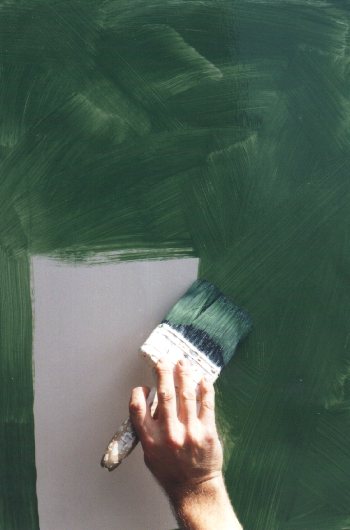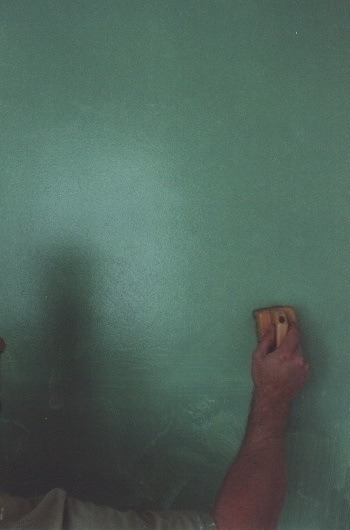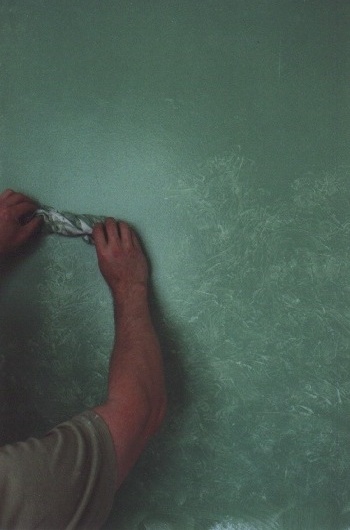- Dust sheets or similar material to protect carpets furniture etc.
- Disposable plastic gloves (optional).
- A bucket or bowl of clean water plus rags for cleaning.
- A tin of paint thinned with transparent glaze according to manufacturers instructions.
- A roller and tray and/or a brush.
- More rags (preferably lint-free cotton) to create the effect.
Like all paint-effects, ragging-off can be a little messy, so wear old clothing or overalls.
Also: remove or cover all carpets, furniture and other valuables from the room.
Prepare
the surface that is to be painted, apply at least 2 coats of mid-sheen paint in your chosen
colour
and allow to dry thoroughly.
Water-based paint dries quickly so start on your smallest walls first; your speed will improve with experience.
Have a bucket or bowl of clean water and some rags close at hand for cleaning purposes.
RAGGING-OFF PROCESS.
In this technique the topcoat, or glaze, is patterned by rolling a crumpled lint-free rag over the surface.
Where the rag makes contact the glaze is lifted revealing the base coat.
It is advisable to get someone else to paint the wall with the mixed glaze ahead of you, so that you can concentrate on creating the effect
If you must work alone, paint small sections, 3ft (1 metre) at a time, & stop the ragging-off process 6 inches (150mm) short of the leading edge.
Apply the mixed glaze evenly with a brush or roller.
You may wish to stipple over the brushed areas to prevent the brush marks showing on the finished effect.
Take a piece of lint-free cotton cloth approximately 18 inches (450 mm) square either dry, or slightly moistened with solvent (for a softer effect).
Solvent = Water for acrylic or emulsion paint.
Solvent = Turpentine or white spirit for oil-based paint.
Roll the cloth into a loose cylinder shape and twist it slightly making sure there are lots of creases and folds.
Hold the cloth in your fingertips and gently roll it on the surface of the glaze using only your fingertips (not the palms of your hands).
The challenge of ragging-off is to move the rag evenly over the surface.
You should roll small sections at a time, about 18 inches (450mm), then lift the rag from the surface and change the angle of the roll.
This is to prevent repartition, although some people prefer this method.
Occasionally open out, and re-bunch the rag to keep a random look to the pattern.
The rag will slowly become saturated with glaze and should be replaced occasionally with more of the same material.
Repeat the process over the area to be decorated, lapping-in on wet edges.
If there are any bare or poorly patterned areas, use a dabbing method to even-out the effect.
Allow the first wall to dry before starting another to prevent spoiling the finished effect.
Allow the paint to dry before protecting with a coat of clear glaze or varnish (optional).

Apply glaze.

Stipple.

Rag-off.
!!! With oil-based
method, used rags must be laid flat and allowed to dry before discarding to prevent spontanious combustion. !!!
The more contrast between the basecoat and topcoat; the more pronounced the pattern will be. (Especially important with this effect)
You should not add white to the basecoat colour to make the topcoat, or vice versa. This gives poor results unless the contrast is strong.
An oil-based basecoat will greatly improve the working time of the glaze. It is advisable to use an oil-based topcoat too in this instance.
A matt or semi-sheen basecoat works best as silk tends to make the rag slip & slide.
Colours should be related in some way, either different tones of the same colour, or similar tones of related colours.
It is advisable to dab a corner of the cloth into internal corners first, then rag-roll up to it. Otherwise the corners will seem bare.
Dark or strong colours give a rich effect, but the base-coat must be fairly light compared to the glaze for the effect to be visible.
Variations in finish can be achieved using different types of material such as mutton cloth or chamois leather rather than cotton.
![]()
![]()